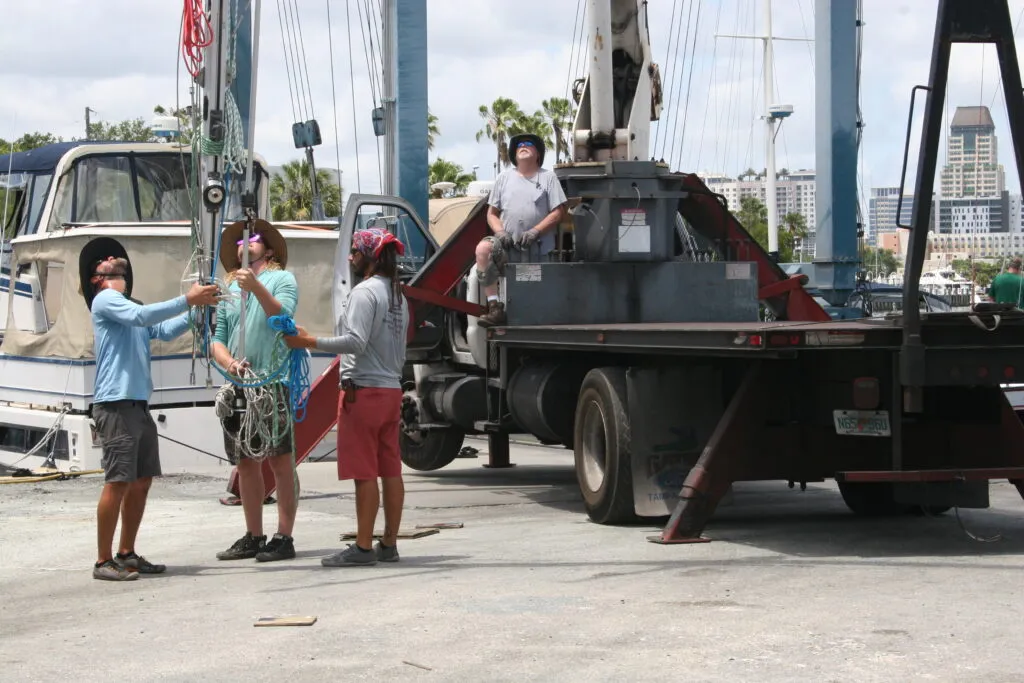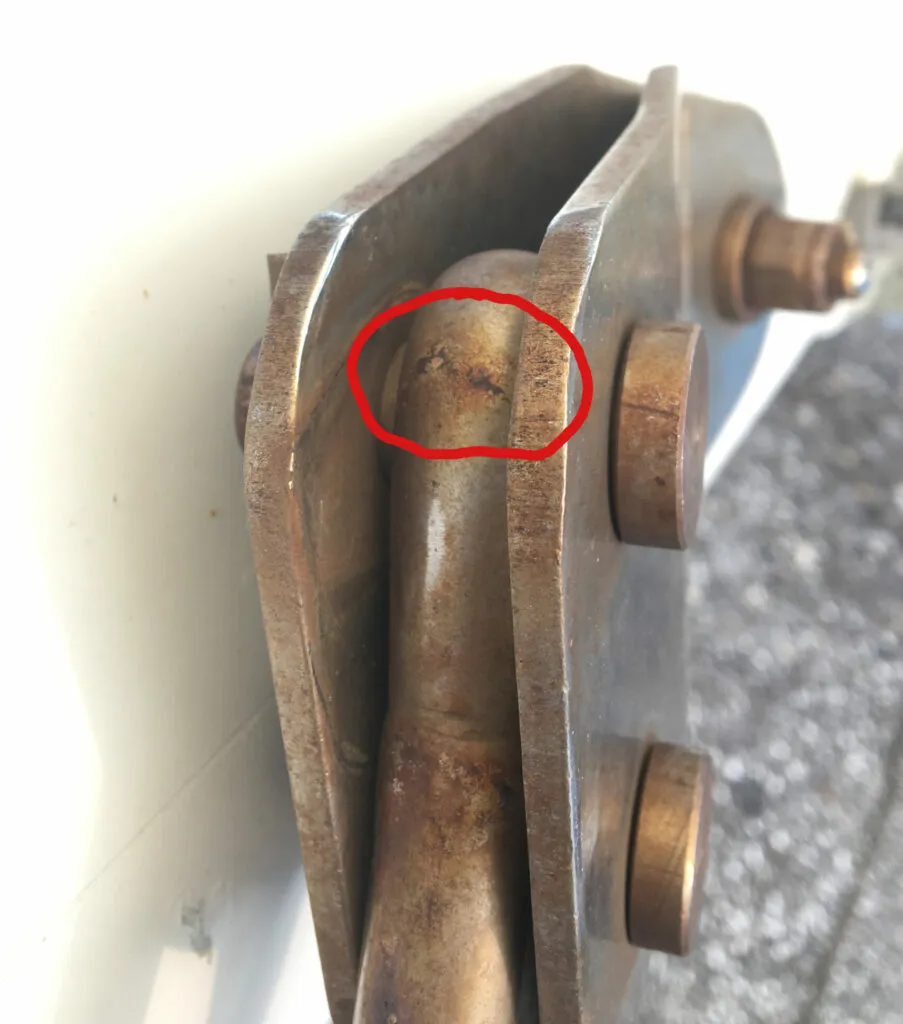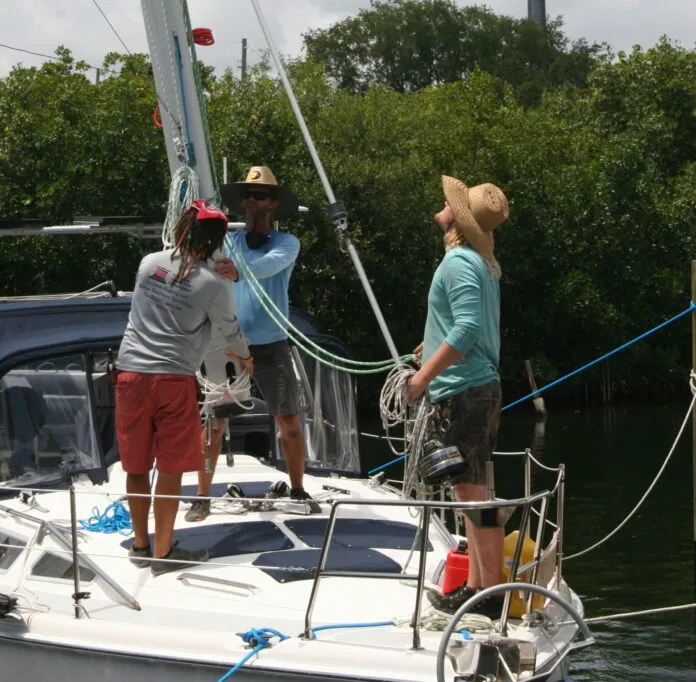You may have noticed that each winter that there seem to be fewer masts in the rack and more still standing upright in boats in the yard. Obviously, there are savings in not unstepping a mast, plus there is the potential for damage when it is unstepped and stepped in spring. (Not to mention the hassle of misplaced clevis pins, etc.)
But what about the forces placed on the boat during the winter when a boat is rigid in a cradle? If a boat is in the water you can see it heel at a mooring on a windy day. But when it is on the hard, and the rig is taking the full force of winter storm—how does that impact the rig?
And what about the impact of drastic temperature change on the rig and hull if your mast is left up? How are the masts and hull impacted by the changes in hull shape caused by the cold in winter? How should the rig be tuned to adjust for these changes?
We often wonder it is only us dinosaurs who still have the yard take the mast down for winter.

If you are like us, you may feel strangely guilty about leaving a mast up in winter. In our case, it is probably those old wooden spar days calling. Ideally, wooden spars need to come down and be sheltered and coddled at regular intervals. Aluminum masts really don’t, and the sky is actually a decent place to store them. In other words, you can leave the mast up on a securely blocked boat but try to reduce windage aloft as much as possible. For example, leaving a furling jib up is a terrible idea (which is why most yards prohibit this.)
Keeping the mast up will usually keep it cleaner than it would be lying across barrels or in racks, where masts tend to collect all sorts of dirt and dreck, even if they’re under cover. Of course, there is the potential for damage when they’re being stepped or unstepped, but this should not be a huge concern when the work is being carried out by experienced professionals.

The biggest trouble with leaving the mast up is that it’s easy to get lazy about close inspection of all parts. Also, ice and salt residue can collect in the tops of the shroud terminals, accelerating corrosion. And chainplates can take an extra beating with the boat held steady and the spar shaking in a heavy wind. This can cause leaks.
Although aluminum masts and stainless wire or rod rigging don’t change much when the temperature goes way up or down, the structure under them can. Depending on the hull dimensions and expected temperature change, it might be advisable to slack off a few turns on the standing rigging for the winter. You don’t want so much slack that it will promote on-off cycle loading.
It would take a mighty big wind or a poor blocking job at the yard for a normal displacement boat to be blown off its poppets. The windage of a bare spar isn’t that much greater than that of a hull rigid on blocks, although the wind blowing on that higher surface has a proportionately greater effect. If you are laying your boat up in hurricane alley, then taking the mast down can increase your chances of surviving unharmed. Sure, there is always a slim chance that a furious winter storm could blow through and upend a well-chocked boat, but if dozens of boats in temperate regions blew off their fortified stands each winter because their masts were up, boatyards would be the first to insist on unstepping.
We suspect that upright-mast trend was started by two things: the ability of the TraveLift to operate without one upper crossbeam in order accommodate a boat with spars up, and the enormous pain in the neck it is to detach the wiring for instruments and lights in today’s boats.
Should you leave your mast up? For a small trailer sailor with a deck stepped mast that doesn’t require a crane, bringing the mast down for winter is a no-brainer. The mast can even serve as a center pole for a winter cover.
For bigger boats, the answer varies from boat to boat. To provide a cut-and-dried, one-size fits all answer for every boat is impossible. The decision is YOURS to make, and hinges primarily on two factors — how much cost and trouble is it to bring it down, and how important it is for you to get a close look at it, perhaps even give your mast a new coat of paint. In general, leaving your mast up through winter does no harm, but if you have concerns about the condition of your rig and want to go over it with a fine-tooth comb (see What’s Hiding in Your Rig?) then the hassle and expense of unstepping the mast can save you big headaches in the future. If your storage yard is in an exposed area subject to repeated gale force winds, ice storms, etc. the yard manager would be your best guide to risk avoidance.

When in doubt, pay for a rig inspection while the mast is in the water. A qualified professional rigger should be able to spot most rigging problems while the rig is up, and many, if not all, can be addressed while the mast is still up. The expense of a rig inspection is usually about half the cost of a crane and operator required to pull the mast and store it, although this rate varies from yard to yard.
If the rigger suggests its time to pull the mast to address some more serious issues , then you’ve gotten your money’s worth. If they say leave it up, you’ve paid for peace of mind. Another consideration is whether you want to upgrade your electronics to an N2K network, which on many boats (like mine, which has an inverted J-shaped tube for the existing wiring to pass) is much easier with the mast down.
Finally, one of the most problematic areas on many older boats is the mast step and compression post, which is practically impossible to repair without taking the mast down. This area deserves a very close inspection, as failure here can bring the entire rig down. Unfortunately, this area is often impossible to inspect on some boats, without disassembling floorboards or bulkheads.
I’d love be interested in hearing about your experiences with mast storage—up or down at [email protected].








































So what do you recommend?
Yeah a bit unsatisfying as an analysis. I’m wondering about just all the wiggling for months, esp since the boat cant wiggle with it like it can in the water.
I am not sure I totally agree with the theory of not much more windage up than down.
Having experienced IRMA first hand once the wind strength reaches a certain amount another danger presents itself from an upright mast.
When they snap and fall, they skew the vessel or most likely the vessel next door. Those that were lucky enough to remain on their stands which were few had other issues due to this.
Secondly, as with all domino effects, once one goes and lands on the next a chain reaction occurs. With no mast up and hull strapped down, one wonders how well the yards may have done.
Yeah, what are the recommendations? I have a deck-stepped mast and wonder if as the mast moves, does it tweak the deck, weakening the structure?
Doesn’t leaving the mast up potentially lead to microscopic cracks in the hull and deck where the shrouds and stays are attached? In a boat yard exposed to moderate or high wind doesn’t the rig vibrate? Where does the energy in the vibrating rig go when the boat is on the hard?
When the trip to winter storage involves waiting for drawbridges there’s an added reason to unstep using the crane in the harbor. With your mast on sawhorses you can inspect carefully, checking the ringing and wiring. You want to go up in a bosun chair in the Spring to check for damage? There is one variable in the decision — it’s easy to unstep a deck stepped mast, keel stepped, not so much.
I winter at a Safe Harbor marina (of which there are 100 or so, including the former Brewer’s Marinas.) My Marina charges more for winter storage stepped – do not understand why, but they do:
SAIL UNSTEP $ 5.50 Sq. Ft.
SAIL STEPPED $ 7.10 Sq. Ft.
I am also required to maintain liability insurance with the marina as an additional insured, so any damage my boat causes to other boats will be covered by my policy.
So, would appreciate Practical Sailor pushing them to explain the rationale behind the difference other than extra income from unstepping and restepping the mast.
ps my winter cover ($3000) assumes the mast to be in place though I guess I can pay the marine for a wooden frame for the cover.
Is it possible that there is less available room for stepped mast boat storage due to overhangs or other barriers? Or is the yard’s ability to crane a boat impacted by having a tall pointy stick to deal with? Perhaps the added cost is to encourage unstepping so they can accommodate as much business as feasible? Just my guesses.
Thanks Darrell; Our group at the harbour all remove our masts with each others’ assistance and with our gin pole, prior to our club lift out day. Where my boat was previously – they lifted out with the masts in. I’m grateful for the opportunity to check things over during the off season and improve a few items as needed. Plus I sleep better knowing the winter winds howling over lake Huron, are less likely to damage my 40 year old boat and rig.
Don
Winter? I have no experience.